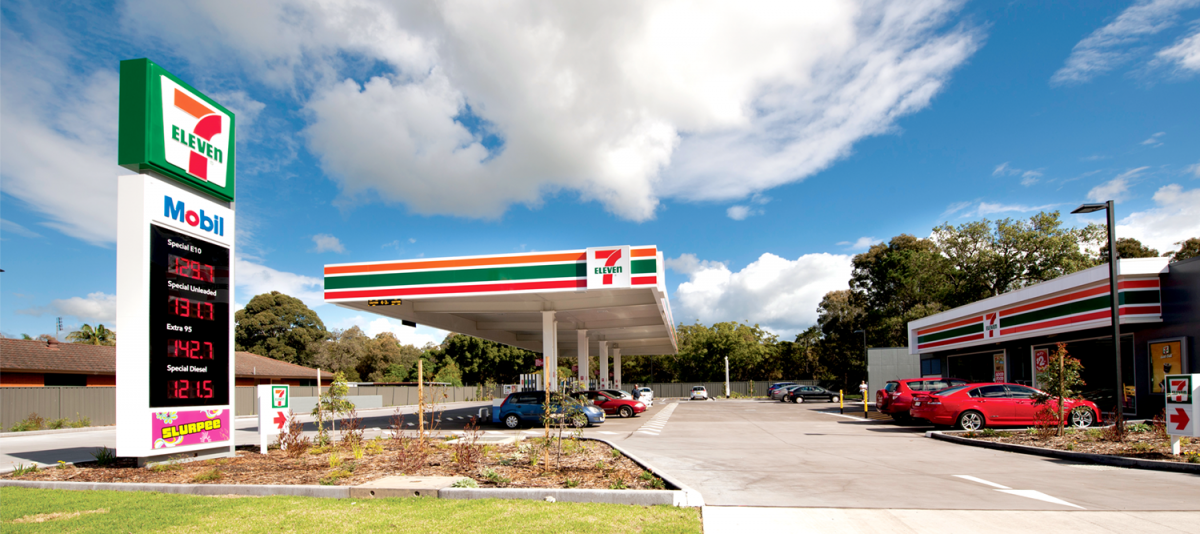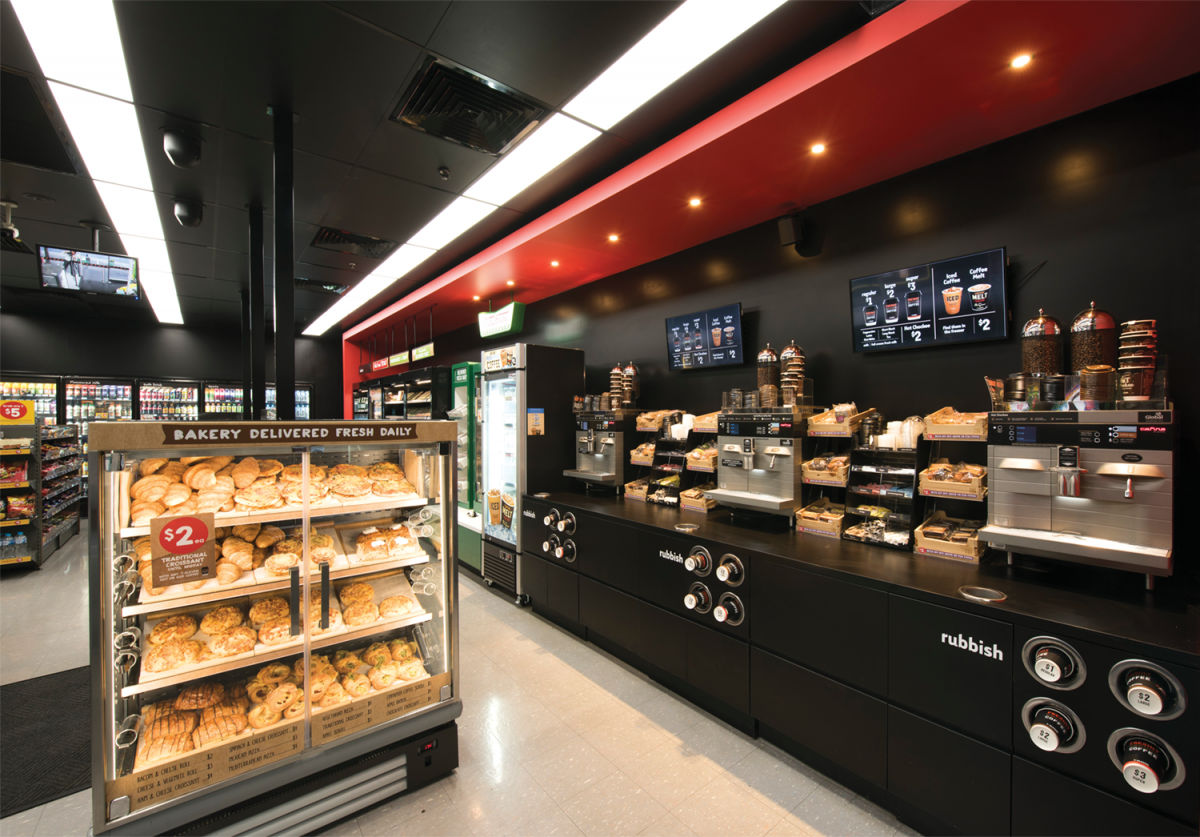7-Eleven Stores Australia is a hotbed of innovation, and it furthers the cause by having an entire department dedicated to business transformation. One of the latest innovations on trial and recently promoted via LinkedIn, is an app that enables mobile checkout.
Stephen Eyears, head of strategy, innovation and business development, highlights the benefits the 7-Eleven brand brings and the retailer’s significant program of innovation work. “One of the benefits to being part of a brand like 7-Eleven is that the company invests in innovation and trials to ensure that new offers are fully tested before they roll out to all stores,” he says. “Under the 7-Eleven model, we fund development, refurbishments and equipment. So, we can invest what’s needed if we think an idea has potential, and then both ourselves and our franchise partners benefit from the incremental growth the idea can deliver.”
The new mobile checkout app is currently on trial in one store in Melbourne’s Central Business District. “We are testing customer acceptance and store usability,” explains Eyears.
 7-Eleven Australia recently won the 2019 NACS Asian Convenience Retail Technology Innovation Award.
7-Eleven Australia recently won the 2019 NACS Asian Convenience Retail Technology Innovation Award.
Increased convenience, however, is the key goal. “What we are always looking to do is find ways that reduce customer friction in terms of engaging with us. Our stores are very busy and popular so we are looking at ways to reduce the amount of time customers have to spend in store and that’s what this app is trying to achieve,” Eyears says.
The ability to conduct the whole shopping experience on a mobile phone is designed to speed shopper missions, Eyears says. It also has a spin-off benefit. “At the same time, it enables us to redirect that labor to store standards and the customer experience,” Eyears says.
While the trial is still in the early stages, the volume of transactions has not been significant. 7-Eleven has purposely elected to initially promote the app in-store with point-of-sale messaging and via store team members talking to customers about the new technology. According to Eyears, that’s to ensure there are “no hiccups in terms of usability.” The next stage will be to promote the app via social media and PR, he says. “LinkedIn is starting the whole process to drive broader engagement to the test,” he says.
Saving Customer’s Time
The user benefits of the 7-Eleven mobile checkout app are very apparent—in busy convenience stores, they no longer need to queue to pay. That shortens their wait time at any time of day.
The app’s mechanics are equally straightforward. When a customer signs up, he or she provides 7-Eleven with payment details and take a “selfie,” which is stored on their phone and is integral to the process (more on that later). Using the app, the customer scans barcodes to add items to their basket or can select items from a favorites button. Six favorite buttons, which cover the top-selling products in 7-Eleven stores including coffee, bottled water and Slurpee, are currently being tested in the trial. They eliminate the need to barcode scan. Again, it’s about 7-Eleven finding new ways to speed up the entire checkout process, Eyears says. While the favorites buttons currently feature bestsellers, the aim—as 7-Eleven gains knowledge and more people are using the app—is to change those buttons to reflect sales, Eyears reports. Ultimately, and if the app is scaled, the buttons will be personalized to the customer to enable them to select their own favorites, he adds.
We don't want to deliver a laborless store; we think having store staff to serve and assist is a positive thing.
The customer selfie meanwhile links to another piece of the mobile checkout solution that 7-Eleven is testing, namely an iPad-based kiosk for store team members. Uploaded with software, it lets front-of-house staff know when people are in the store and using the app. As items are scanned and dropped into baskets, front-of-house teams can see what’s happening. The kiosk also displays the customer’s photo so that team members can immediately identify a shopper that’s using the mobile checkout solution and the products they are putting in their basket. In addition, staff is alerted when a shopper has hit the payment button.
According to Eyears, the dual goal is to discover whether mobile checkout is a form of shopping that customers want to do and whether the technology gives team members confidence in regard to what is happening in store—which customers are self-scanning and which are going to come up to checkout.
Enhancements
Comparisons between 7-Eleven’s mobile checkout solution and Amazon Go are ill founded, Eyears maintains. “It’s not about us doing an Amazon Go, and it’s not about us trying to deliver a laborless store—we think having store staff to serve and assist is a real positive thing,” he says. “Amazon Go is not a laborless store—that’s a misconception,” he adds. “For other models that have been touted to compete with Amazon Go, you have to be a member of a club. We don’t want a system that makes our stores only available to people that are in the club. We want mobile checkout to be an option for customers, but not the only way to engage with us.”
 As customers scan items and drop them into baskets, front-of-house teams can see what’s happening via the app.
As customers scan items and drop them into baskets, front-of-house teams can see what’s happening via the app.
Another unique feature of the 7-Eleven solution is that if it works from a customer and store adoption point of view, it can be scaled extremely quickly. “There’s no putting in expensive hardware, redesigning layouts or closing the doors to those customers that don’t wish to use the technology,” Eyears says.
Ramping up the promotion of the new app should drive user numbers, crucial for thorough testing of the solution for store teams, Eyears reports. “We really have to put them under a bit of pressure, add some volume and test the usability,” he says.
7-Eleven has also been busy engaging with staff and not just at the trial store but across its network. “We’ve gathered a lot of feedback about the store kiosk in particular and what would make it more usable,” he says. Eyears reports that one suggestion from one of the working groups that previewed the material was to add sound to the kiosk and not just visuals. “So we are working with the front line to add refinements,” he explains.
Questions surrounding theft are raised frequently. “My hypothesis that we will test is that it will not be the case,” Eyears says. “If customers are willing to sign up to the app, give their payment details and expose their image, first of all, it’s likely that they are going to be a regular customer. Secondly, if I they are going to give all that information, I doubt that they are going to be the shoplifting type. The app will appeal to regular customers that are in store every day or twice a day, not to those that only shop with us occasionally, so my hypothesis is that it’s not going to drive theft.”
About 7-Eleven Stores Pty
7-Eleven Stores Pty Ltd is a private company owned by the Withers and Barlow family. The company has a license to operate and franchise 7-Eleven stores in Australia from the U.S.-based 7-Eleven Inc.
The first Australian store was opened in August 1977. Today, 7-Eleven Stores Pty Ltd. operates more than 670 stores in Queensland, New South Wales, Victoria, the Australian Capital Territory and Western Australia. Through its store network, 7-Eleven Stores Pty Ltd. conducts more than 190 million transactions a year, serving an average six customers per second, generating sales of approximately $3.6 billion.
Future-Proofing
While it’s still early days, the future looks bright. “Store teams and franchisees all love the idea of whatever we can do to reduce queues—people waiting and putting pressure on the front line—and enabling staff to focus on store standards, cleanliness and great customer engagement. That’s something that’s been very positive,” Eyears says.
The mobile checkout solution is also future-proofing the business, he adds. “There will be a time and, perhaps not a decade away, when cash is going to become very minimal in the store environment.” In terms of “tap and go” or contactless payments, Australia is 10 years ahead of the U.S., he maintains.
Critically, the app brings another huge business benefit to 7-Eleven, as Eyears acknowledges. “If we can utilize the functionality in an app, it’s another reason for customers to engage with us and give us a level of detail that otherwise we would not have—it’s the ability to get into a digital, two-way conversation,” he says.
And that will surely spark further innovation.
This article was reprinted with permission from Global Convenience Store Focus, the newsletter of Insight Research. For more information visit here.
Winner! Winner!
 7-Eleven Stores Australia has won the first-ever NACS Asian Retail Technology Award. The award, graciously sponsored by PDI, honors retailers that are making far-sighted, long-term investments in technology innovation, keeping the retail environment convenient and hassle-free for customers. The award was given at this year’s NACS Convenience Summit Asia, which took place March 5-7 in Shanghai, China. Attendees experienced a robust conference agenda of inspiring speakers and case studies, thought-provoking discussions on topics such as next generation payments, robotics and big data from FamilyMart, Hema and PetroChina, as well as interactive store tours. Visit here for more information on the event.
7-Eleven Stores Australia has won the first-ever NACS Asian Retail Technology Award. The award, graciously sponsored by PDI, honors retailers that are making far-sighted, long-term investments in technology innovation, keeping the retail environment convenient and hassle-free for customers. The award was given at this year’s NACS Convenience Summit Asia, which took place March 5-7 in Shanghai, China. Attendees experienced a robust conference agenda of inspiring speakers and case studies, thought-provoking discussions on topics such as next generation payments, robotics and big data from FamilyMart, Hema and PetroChina, as well as interactive store tours. Visit here for more information on the event.
Sponsored by 